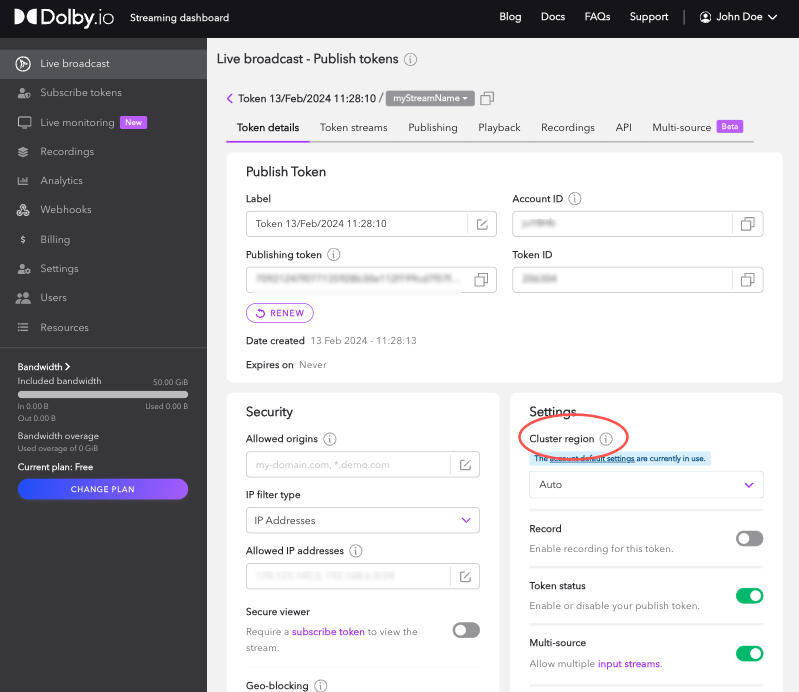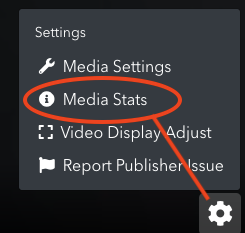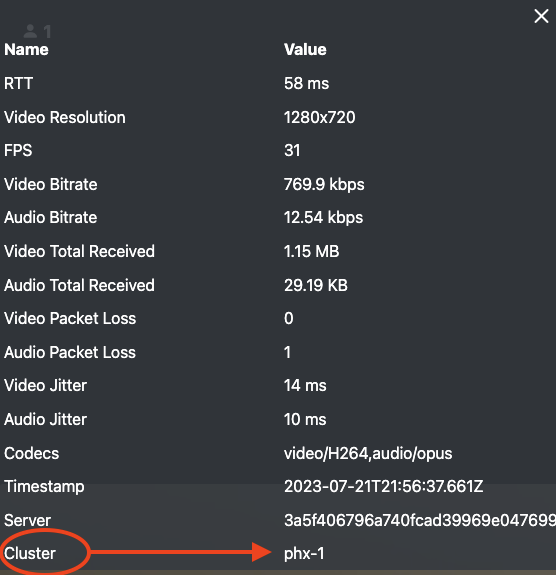Multi-Region Support
Content Delivery Network with Cluster Regions for Global Distribution at Scale
The WebRTC Content Delivery Network (CDN) refers to geographically distributed clusters of servers which work together to provide real-time streaming worldwide at scale. Dolby.io distributes streaming content across multiple regions through a network of cloud hosting providers.
A traditional CDN needs to cache live stream segments on a network before they are able to be delivered to viewers over HTTP. This operation would generally add many seconds of latency to a live stream. The intelligent scaling provided by Dolby.io over global infrastructure is what enables increasingly large audiences with concurrent streams to experience ultra low latency.
This guide covers a few examples:
- How-to Set the Cluster Region Using the Dashboard
- How-to Identify the Cluster Region for an Active Stream
- How-to Get Available Cluster Regions with the REST API
- How-to Set the Cluster Region for a Publish Token with the REST API
Geo-Cascading
If you want to learn how to customize how traffic flows across regions, review the Geo-cascading streaming guide.
Overview
A publishing token is configured with a specific cluster region. This value indicates which data center should be used as the origin when broadcasting. It can be explicitly set independently for each discrete token or be automatically assigned from the account's overall configuration.
- Auto will use geo-detection to choose a region
When creating a publishing token, selecting the region that is closest to the broadcast location will improve latency and quality. The publishing cluster region setting can be configured to one of the following specific regions:
North America
| Cluster Code | Region Location |
|---|---|
| iad-1 | Ashburn, Virginia, United States |
| phx-1 | Phoenix, Arizona, United States |
South America
| Cluster Code | Region Location |
|---|---|
| sao-1 | Sao Paulo, Brazil |
Europe
AMS Region Traffic
The
ams-1region will be discontinued after September 30, 2024. For any active publish tokens, you should update them to use either the lon-1 or fra-1 regions. If you currently are using auto any streaming traffic will be re-routed automatically.
| Cluster Code | Region Location |
|---|---|
| fra-1 | Frankfurt, Germany |
| lon-1 | London, England |
Asia Pacific
| Cluster Code | Region Location |
|---|---|
| blr-1 | Bangalore, India |
| sgp-1 | Singapore |
| syd-1 | Sydney, Australia |
Cluster regions in the dashboard
You can manage cluster regions by changing settings from user interface of the Streaming Dashboard.
Getting Started
If you haven't already, begin by following the Getting Started tutorial to create a Dolby.io application and start your first broadcast. You will need to have a publishing token. See Managing Your Tokens for more details about tokens.
Blocking Regional Access
If you are looking to stop streaming traffic in a particular geographic region, see the Geo-blocking streaming guide for details on how to restrict access of content distribution.
How-to set the cluster region using the dashboard
Open the Streaming section of the Dolby.io Dashboard. Select the publishing token you want to modify. Within the Settings section you can choose the Cluster Region from the dropdown.

How-to identify the cluster region for an active stream
When using the Dolby.io Dashboard publisher to broadcast or the viewer to playback you can select the gear setting to view the Media Stats.

This will display a modal overlaying the stream with details about resolution, bitrate, etc. and will also display the Cluster value using one of the region codes.

REST APIs
When working with clusters you can automate workflows using available REST APIs.
- The /api/cluster endpoint allows you to query available cluster regions or change the default cluster for your account
- The /api/publish_token endpoint allows you to update the cluster for an existing publish token or to define a value when creating a new token
Using the REST APIs
Review the REST API platform guide for more details on generating an API secret for authentication. You will need an API Secret from the dashboard in order to make requests.
How-to get the available cluster regions
You make a GET request with the /api/cluster endpoint to fetch details about the defaultCluster and a list of the availableClusters to find the list of available cluster regions.
The results may look like this:
{
"status": "success",
"data": {
"defaultCluster": "auto",
"availableClusters": [
{
"id": "ams-1",
"name": "Amsterdam",
"rtmp": "rtmp-ams-1.millicast.com",
"srt": "srt-ams-1.millicast.com"
},
{
"id": "auto",
"name": "Auto",
"rtmp": "rtmp-auto.millicast.com",
"srt": "srt-auto.millicast.com"
},
{
"id": "blr-1",
"name": "Bangalore",
"rtmp": "rtmp-blr-1.millicast.com",
"srt": "srt-blr-1.millicast.com"
},
{
"id": "fra-1",
"name": "Frankfurt",
"rtmp": "rtmp-fra-1.millicast.com",
"srt": "srt-fra-1.millicast.com"
},
{
"id": "iad-1",
"name": "Ashburn",
"rtmp": "rtmp-iad-1.millicast.com",
"srt": "srt-iad-1.millicast.com"
},
{
"id": "lon-1",
"name": "London",
"rtmp": "rtmp-lon-1.millicast.com",
"srt": "srt-lon-1.millicast.com"
},
{
"id": "phx-1",
"name": "Phoenix",
"rtmp": "rtmp-phx-1.millicast.com",
"srt": "srt-phx-1.millicast.com"
},
{
"id": "sao-1",
"name": "Sao Paulo",
"rtmp": "rtmp-sao-1.millicast.com",
"srt": "srt-sao-1.millicast.com"
},
{
"id": "sgp-1",
"name": "Singapore",
"rtmp": "rtmp-sgp-1.millicast.com",
"srt": "srt-sgp-1.millicast.com"
},
{
"id": "syd-1",
"name": "Sydney",
"rtmp": "rtmp-syd-1.millicast.com",
"srt": "srt-syd-1.millicast.com"
}
]
}
}
How-to set the cluster region default
You make a PUT request with the /api/cluster endpoint to update the default account cluster that is used when creating new publishing tokens.
For example, you can use curl to set the default cluster for any new tokens to Amsterdam.
curl --request PUT \
--url https://api.millicast.com/api/cluster \
--header "Authorization: Bearer $DOLBYIO_API_SECRET"
--data '{
"defaultCluster": "ams-1"
}'
How-to set the cluster region for a publish token
You make a POST request to /api/publish_token in order to create a new token. The originCluster parameter specifies the cluster to use. This should be specified using the abbreviated code. You can make a PUT request to /api/publish_token/{tokenId} to change the cluster region for an existing token.
For example, you can create a new token for Amsterdam.
curl --request POST \
--url https://api.millicast.com/api/publish_token \
--header 'Content-Type: application/json' \
--header "Authorization: Bearer $DOLBYIO_API_SECRET" \
--data '{
"label": "amsterdam-token",
"streams": [{"streamName": "myStream"}],
"originCluster": "ams-1"
}'
Enable Multisource on your Stream Token
For using multi-source streams, your account must be allowed to use the multi-source feature and the Publish Token must have the
multisourceflag enabled. The default cluster region must not be set to auto, and must be set to the region from which you want to stream. Multi-source will not work if you publish the stream from two different locations that do not fall under same cluster/region coverage and the current default setting has not been modified. For more information, see Multisource Broadcasting.
Troubleshooting
Unauthorized
If you receive an Unauthorized error make sure that you are specifying an Authorization header and that it is passing in a valid API Secret from your Streaming dashboard.
{"status":"fail","data":{"message":"Unauthorized"}}
Unsupported media type
If you receive an Unsupported Media Type error make sure you are specifying the Content-Type header.
{"status":"fail","data":{"message":"Unsupported Media Type"}}
Validation error: CreateStreamNameModel
If you receive Validation errors from a REST request make sure you are providing all of the required parameters. For example, you may see this error if you don't specify the streams parameter as a list of dictionaries.
{
"status": "fail",
"data": {
"errors": {
"$.streams[0]": [
"The JSON value could not be converted to Millicast.CustomerApi.Models.Tokens.Request.CreateStreamNameModel. Path: $.streams[0] | LineNumber: 2 | BytePositionInLine: 28."
]
},
"message": "Validation errors"
}
}
Learn more
Learn more by exploring the developer blog and code samples.
Updated 7 months ago